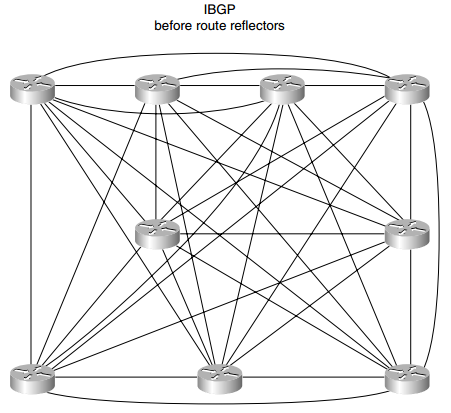CCNP Route FAQ: Implementing and Tuning BGP for Use in Large Networks
Q1. If a route reflector hears an update from a nonclient, what action will be taken?
Q2. In version 11.0 of the Cisco IOS, what method would be used to restrict routing information from being received or propagated?
Q3. Explain the purpose and use of the command show ip prefix-list name [seq seq-number].
Q4. How and why would you redistribute static routes into BGP-4?
Answer: Static routes would be redistributed into BGP-4 with these commands:
router bgp 100
redistribute static
ip route 201.33.0.0 255.255.0.0 null 0
The static routes are forwarded to the nonexistent interface null 0 to aggregate the routes to create a supernet. This is then redistributed to the BGP process instead of the hundreds of routes that exist. Because any route redistributed into BGP-4 must be in the IP routing table, this is a way of creating a supernet and having it redistributed.
A static route to null 0 is not needed if the network command is used and no address aggregation is performed.
Q5. Give the command that would change the weight attribute for the path to the next hop 192.16.5.3.
neighbor 192.16.5.3 weight 48
Q6. Why do route reflectors have to be fully meshed with IBGP-4?
Figure: IBGP-4 and a Fully Meshed Network
Q7. Why is filtering often required when redistributing BGP-4 into an IGP?
Q8. What are the advantages of multihoming?
Q9. What are the two most common forms of multihoming?
- The ISPs send default routes into the autonomous system.
- The default routes and some selected routes are sent by the ISP into the autonomous system.
- All routes known by the ISP are sent into the autonomous system.
Q10. Which command will show the local preference and weight attribute values?
Q11. Why does IBGP-4 need to be fully meshed?
Q12. How is a fully meshed network avoided in IBGP-4?
Q13. What is the formula to determine the number of sessions needed in a fully meshed BGP-4 network?
Q14. Why does a fully meshed network in IBGP-4 cause problems?
Q15. State two benefits to using route reflectors.
Answer: Route reflectors have many benefits:
- The use of a router reflector means that fewer TCP peer connections are needed. This streamlines the network traffic and solves the excessive use of network resources sometimes incurred with a fully meshed network.
- The design and configuration are very straightforward, which means that it is easy to implement and thus to migrate an existing network, particularly because path attributes are not affected by them.
- Despite the fact that the route reflectors are straightforward, the flexibility in the design means that it is possible to become very sophisticated using redundant route reflectors and even multiple levels of route reflectors. Complex solutions are possible using router reflectors.
Q16. Can the next-hop-self option be used between EBGP-4 peers?
Q17. Explain the difference between a cluster-ID and an originator-ID.
Q18. State two advantages in using prefix lists over access lists.
Answer: The advantages of using prefix lists are the same as those of access lists. The advantages of using prefix lists instead of access lists include the following;
- They have a better performance than access lists.
- They allow editing of the lists so that additional lines of code can be inserted anywhere in the list.
- The user interface is easier to use.
- They are more flexible.
Q19. If the ISP has provided a default route, how will the router within the autonomous system select the exit path in a multihomed environment?
Q20. What is a disadvantage of an autonomous system receiving full routing updates from all providers?
Q21. What is the danger of redistributing BGP-4 into the IGP?
Q22. What are the advantages of a fully meshed IBGP-4 network?
Q23. In configuring a route reflector, how is the client configured?
neighbor ip address route-reflector-client
Q24. What command is used to display the route reflector clients?
Q25. What commands are used to display the BGP-4 router ID that identifies the router that is sending the updates and peering with its neighbor?
Q26. Which command is used to display the AS path?
